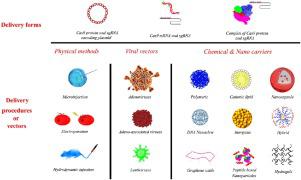当前位置:
X-MOL 学术
›
Nano Today
›
论文详情
Our official English website, www.x-mol.net, welcomes your
feedback! (Note: you will need to create a separate account there.)
Harnessing nanoparticles for the efficient delivery of the CRISPR/Cas9 system
Nano Today ( IF 13.2 ) Pub Date : 2020-10-01 , DOI: 10.1016/j.nantod.2020.100895 Hossein Rahimi , Marziyeh Salehiabar , Jalil Charmi , Murat Barsbay , Mohammadreza Ghaffarlou , Mahdi Roohi Razlighi , Soodabeh Davaran , Rovshan Khalilov , Minetaka Sugiyama , Hamed Nosrati , Saeed Kaboli , Hossein Danafar , Thomas J. Webster
Nano Today ( IF 13.2 ) Pub Date : 2020-10-01 , DOI: 10.1016/j.nantod.2020.100895 Hossein Rahimi , Marziyeh Salehiabar , Jalil Charmi , Murat Barsbay , Mohammadreza Ghaffarlou , Mahdi Roohi Razlighi , Soodabeh Davaran , Rovshan Khalilov , Minetaka Sugiyama , Hamed Nosrati , Saeed Kaboli , Hossein Danafar , Thomas J. Webster

|
Abstract Exploiting bacterial DNA-acting enzymes and expanding their repertoire for genome engineering have been major technological and conceptual advances in molecular biology over the last decade. The CRISPR-Cas9 system offers many attractive superiorities, such as multiplexing, high precision, low cost, and simplicity compared to other strategies/systems/approaches known to date for gene editing. The efficient co-delivery of Cas9 and single guide RNA(s) into a desired cell and subsequent correct targeting of selected genomic fragment(s) are among the most critical and determining issues for CRISPR-Cas9-based genome engineering. CRISPR/Cas9 components can be transported into target cells via various delivery methods, including physical methods (such as electroporation and microinjection) as well as viral and non-viral methods. Physical and viral methods, with all their privileges, still suffer from disadvantages including induction of immune responses, cell damage, lack of high specificity, etc. We are witnessing a remarkable increase in the employment of nanomaterials as non-viral carriers for the delivery of the CRISPR/Cas9 system. Nanoparticles have so far presented numerous advantages such as ease of synthesis, high efficiency, low cost, size tunability, non-mutagenicity, non-immunogenicity, etc. with regard to the delivery of CRISPR/Cas9. Here, we will review the recent progress in the delivery of CRISPR/Cas9 system components via nanomaterials and outline future challenges.
中文翻译:

利用纳米粒子有效传递 CRISPR/Cas9 系统
摘要 在过去的十年中,利用细菌 DNA 作用酶并扩展它们的基因组工程库是分子生物学的重大技术和概念进步。与迄今为止已知的基因编辑其他策略/系统/方法相比,CRISPR-Cas9 系统提供了许多吸引人的优势,例如多路复用、高精度、低成本和简单性。将 Cas9 和单向导 RNA 有效地共同递送到所需细胞中以及随后正确靶向选定的基因组片段是基于 CRISPR-Cas9 的基因组工程的最关键和决定性问题。CRISPR/Cas9 成分可以通过各种递送方法转运到靶细胞中,包括物理方法(如电穿孔和显微注射)以及病毒和非病毒方法。物理和病毒方法,尽管有其所有优势,仍然存在缺陷,包括诱导免疫反应、细胞损伤、缺乏高度特异性等。我们正在目睹纳米材料作为非病毒载体的显着增加用于递送CRISPR/Cas9 系统。迄今为止,纳米粒子在 CRISPR/Cas9 的传递方面表现出许多优点,例如易于合成、高效、低成本、尺寸可调、非诱变性、非免疫原性等。在这里,我们将回顾通过纳米材料提供 CRISPR/Cas9 系统组件的最新进展,并概述未来的挑战。我们正在目睹纳米材料作为非病毒载体用于 CRISPR/Cas9 系统递送的显着增加。迄今为止,纳米粒子在 CRISPR/Cas9 的传递方面表现出许多优点,例如易于合成、高效、低成本、尺寸可调、非诱变性、非免疫原性等。在这里,我们将回顾通过纳米材料提供 CRISPR/Cas9 系统组件的最新进展,并概述未来的挑战。我们正在目睹纳米材料作为非病毒载体用于 CRISPR/Cas9 系统递送的显着增加。迄今为止,纳米粒子在 CRISPR/Cas9 的传递方面表现出许多优点,例如易于合成、高效、低成本、尺寸可调、非诱变性、非免疫原性等。在这里,我们将回顾通过纳米材料提供 CRISPR/Cas9 系统组件的最新进展,并概述未来的挑战。
更新日期:2020-10-01
中文翻译:

利用纳米粒子有效传递 CRISPR/Cas9 系统
摘要 在过去的十年中,利用细菌 DNA 作用酶并扩展它们的基因组工程库是分子生物学的重大技术和概念进步。与迄今为止已知的基因编辑其他策略/系统/方法相比,CRISPR-Cas9 系统提供了许多吸引人的优势,例如多路复用、高精度、低成本和简单性。将 Cas9 和单向导 RNA 有效地共同递送到所需细胞中以及随后正确靶向选定的基因组片段是基于 CRISPR-Cas9 的基因组工程的最关键和决定性问题。CRISPR/Cas9 成分可以通过各种递送方法转运到靶细胞中,包括物理方法(如电穿孔和显微注射)以及病毒和非病毒方法。物理和病毒方法,尽管有其所有优势,仍然存在缺陷,包括诱导免疫反应、细胞损伤、缺乏高度特异性等。我们正在目睹纳米材料作为非病毒载体的显着增加用于递送CRISPR/Cas9 系统。迄今为止,纳米粒子在 CRISPR/Cas9 的传递方面表现出许多优点,例如易于合成、高效、低成本、尺寸可调、非诱变性、非免疫原性等。在这里,我们将回顾通过纳米材料提供 CRISPR/Cas9 系统组件的最新进展,并概述未来的挑战。我们正在目睹纳米材料作为非病毒载体用于 CRISPR/Cas9 系统递送的显着增加。迄今为止,纳米粒子在 CRISPR/Cas9 的传递方面表现出许多优点,例如易于合成、高效、低成本、尺寸可调、非诱变性、非免疫原性等。在这里,我们将回顾通过纳米材料提供 CRISPR/Cas9 系统组件的最新进展,并概述未来的挑战。我们正在目睹纳米材料作为非病毒载体用于 CRISPR/Cas9 系统递送的显着增加。迄今为止,纳米粒子在 CRISPR/Cas9 的传递方面表现出许多优点,例如易于合成、高效、低成本、尺寸可调、非诱变性、非免疫原性等。在这里,我们将回顾通过纳米材料提供 CRISPR/Cas9 系统组件的最新进展,并概述未来的挑战。











































 京公网安备 11010802027423号
京公网安备 11010802027423号